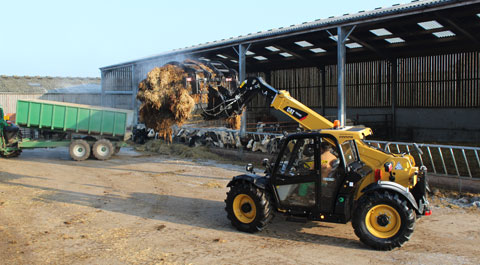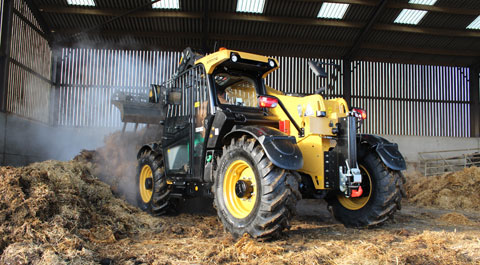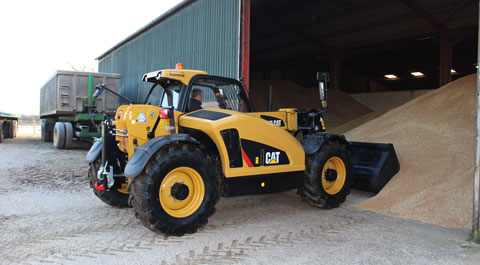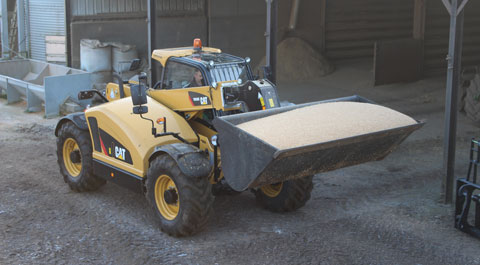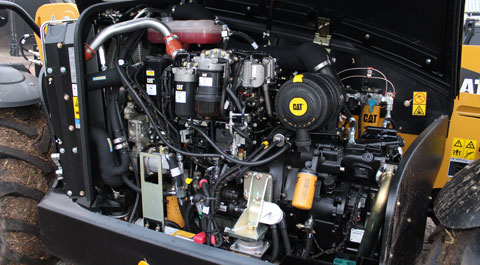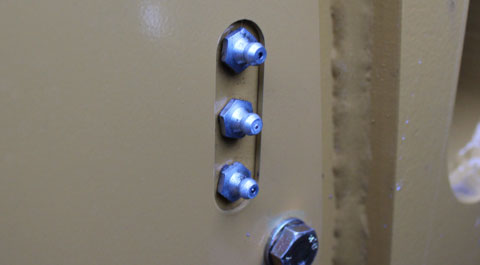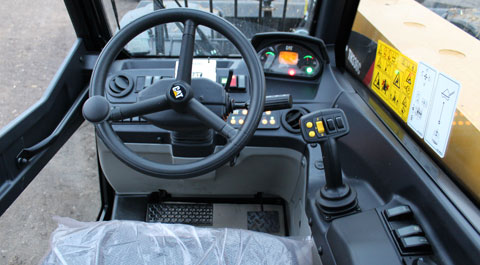First Drive: Caterpillar TH336C handler
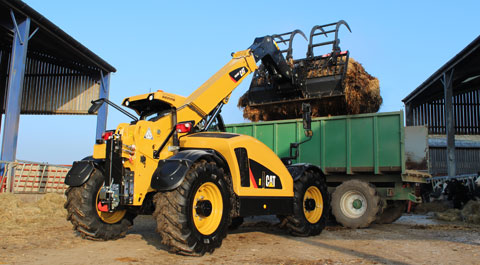
The TH336C seems to be a good machine. Its power is impressive – even with the standard 124hp motor – and the transmission manages to put it to the ground very effectively. Exterior build quality is good and it looks like it will stand up to abuse pretty well. It’s just a shame that the cab hasn’t been finished to quiet the same standard.
Early Caterpillar telehandlers looked a little bit out of place in the farmyard.
Their long, low chassis and hefty build made them look like they had been plucked straight from a building site – and short of a few tweaks, they had.
But over the years Cat has made its machines more farmer friendly and its latest C-series machines have been designed specifically for agricultural use.
We got our hands on a TH336C, which with its 3.3t lift capacity and 6m reach is the baby of the range. It replaces the TH336 and benefits from a new transmission, engine and a strengthened chassis. There have been quite a few changes in the cab, too, including a new joystick, dash and air conditioning system.
Unlike earlier Cat telehandler models that were built at the firm’s Desford factory in Leicestershire, the TH336C is assembled at the JLG plant in Belguim. It’s still designed in the UK though and is built using Caterpillar parts.
Up close the TH336 makes Tonka toys look flimsy. All the metal bits are stamped out of thick plate and the plastics are pretty tough, too.
Having a wheel sticking out on each corner is another plus point, making it harder for spatially challenged operators to ding the bodywork.
It’s good to see a full metal belly shield protecting all the fragile running gear, too.
The only things that really let the side down are the flappy ‘Christmas tree’ of mirrors and the poorly positioned headlights that obscure the carriage. These get pretty annoying when picking up implements so it’s a good job they’re easy to relocate.
Cat has clearly spent some time making the C-series easy to look after. Most of the 22 grease nipples have been conveniently grouped together and they’ve been thoughtfully placed, too.
This means limited grovelling around in the muck and an end to ripping off pieces of argumentative bodywork.
HYDRAULICS
Thanks to a powerful 150-litre/minute pump, the Cat is no slouch when it comes to hydraulic performance. We found it responsive even at relatively low revs and the cycle time (lifting to the top and dropping again) was comparable with the test farm’s larger Merlo P40.7.
But we did have a couple of niggles.
Cat has fitted a button on the dash that switches the hydraulics between bucket and pallet modes. Pallet mode reduces hydraulic flow allowing finer adjustments to be made, while bucket mode gives you full power to get the job done quickly.
When loading a grain lorry, though, we found bucket mode far too aggressive. One slight nudge to the right with the joystick instantly dropped the bucket to full tip, leaving an embarrassed tester reaching for the shovel and broom.
Switching to pallet mode wasn’t a great option either as it slowed the boom down too much.
Fortunately, Cat says that dealers can go into the computer system and change the severity of the bucket and pallet mode settings, which we’d definitely recommend.
We also think the carriage sits too close to the front wheels. When crowding the bucket we managed to tap the front wheels and ended up working with the boom out slightly to avoid any accidents.
SAFETY
As far as irritating safety systems go, Caterpillar’s is more Richard Hammond than Keith Chegwin.
Thankfully there’s no kill switch on the joystick, so you don’t have to keep gripping it until your knuckles go white. And there’s no annoying lockout on the boom either.
If you do happen to push it too far the boom will slow down, stop and let you retract it slowly to a safe position – not too irritating.
It is possible to get the back wheels off the ground, but it requires some pretty creative driving.
ENGINE
Grunt is provided by a new 4-pot Cat/Perkins engine that pumps out 125hp in standard spec and 142hp if you write a slightly bigger cheque.
Our test machine was fitted with the 125hp version and we found it had ample power for everything we threw at it. In the lower gears it was impressively torquey and when pushing up muck it just kept forging on however hard we thrashed it. The extra power might be handy if you do a lot of towing.
Cat has also fitted an automatic reversing fan to help keep its nose clean in dusty places. This will kick in automatically, but the driver can also do it manually by flicking a switch on the dash.
Moving to a Stage 3b engine might bring more power, but it has got a downside. Because Cat has had to shoehorn a bigger cooling pack and a bulky diesel particulate filter under the side bonnet, the hood has got considerably taller. This means you now get a pretty poor view out of the right-hand side.
Another minor gripe in the engine department is the delay between turning the key and the engine firing. It’s only a few seconds, but if you’re hopping on and off it gets a tad annoying.
TRANSMISSION
The old model’s five-speed manual box has been ditched in favour of a six-speed powershift.
This is controlled via two buttons on the top of the main joystick, which are much more handy to use than the old model’s column shifter. Because of this we definitely made better use of the gears.
It doesn’t really feel like a powershift though. When changing on the move there is a clear break in power and a noticeable delay between shifts.
We found some gears quicker to shift than others – probably because some require one clutch change and some two – and it was generally smoother if we lifted off the throttle before selecting the next cog.
There’s no automatic mode, but with only six gears to flick though it’s not a hardship to keep prodding the buttons.
The cab interior isn’t the best you’ll find.
The dash has been wrapped in disappointingly cheap black plastic and it’s got a comedy built-in ring binder that holds load charts and other must-have information.
That said, once it’s covered in half an inch of dust you probably won’t think about it.
Happily, the joystick feels more solid. It’s good job too, because this is home to all the vehicles main controls, including gearshifts and the forward/reverse shuttle. There’s also a trigger to put the boom into float for following ground contours.
Having the forward/reverse shuttle in this position is neat, but won’t be to everyone’s liking. We found ourselves repeatedly grabbing at thin air where you’d normally find the left-hand reverser. And we kept getting our thumbs tied in knots while trying to change direction and move the boom at the same time.
We do like the big, heavy-duty metal pedals and switchable transmission dump on the brake though.
A handy pressure release switch has also been added that makes it much easier to remove hydraulic pipes on the third service. This doubles up as a constant pumping switch for implements such as bucket brushes, too.
LIKES
- Smooth, powerful engine
- Impressive turning circle
- Powerful hydraulics
- Tough exterior build quality
GRIPES
- Poor quality plastics in cab
- Irritating delay before engine starts
- Wobbly mirrors
- Visibility could be better
Caterpillar C-series specs
| TH336C | TH337C | TH406C | TH407C | |
|---|---|---|---|---|
| Engine | Perkins 4.4-litre, 4 cylinder | Perkins 4.4-litre, 4 cylinder | Perkins 4.4-litre, 4 cylinder | Perkins 4.4-litre, 4 cylinder |
| Power | 124hp* | 124hp* | 124hp* | 124hp* |
| Transmission | Powershift 6F/3R | Powershift 6F/3R | Powershift 6F/3R | Powershift 6F/3R |
| Lift capacity | 3.3t | 3.3t | 3.7t | 3.7t |
| Lift height | 6.1m | 7.3m | 6.1m | 7.3m |
| Hydraulics | 150 litres/min | 150 litres/min | 150 litres/min | 150 litres/min |
| Unladen weight | 6.8t | 7t | 7.7t | 7.9t |
| Turning circle (over wheels) | 3.75m | 3.82m | 3.75m | 3.82m |
| Price | £73,826 | £76,033 | £74,898 | £78,766 |
*£2,117 to upgrade to 142hp engine

